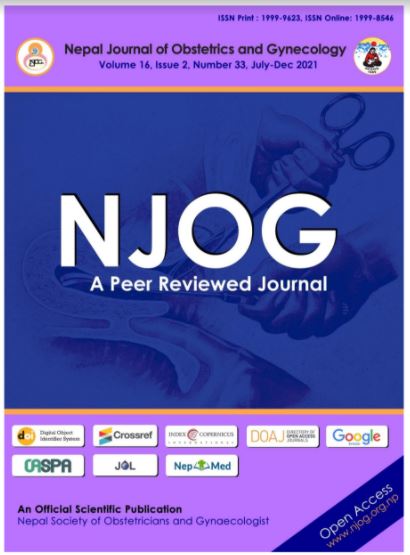Maternal and Fetal Outcomes in Active versus Expectant Management of prelabor rupture of membrane
Keywords:
Active treatment, expectant management, PGE1, PROMAbstract
Aim: To assess the effects of planned early birth (active treatment within 24hrs) compared to expectant management (without active treatment within 24hrs) for women at term with Prelabor Rupture of Membrane (PROM) on maternal and fetal outcomes.
Methods: This is an observational comparative study carried out in all the pregnant women who present in maternity ward of Shree Birendra Hospital with PROM at 37-41 weeks of gestation with vertex presentation during the study period between 13 April 2020 to 13 April 2021.They were randomly placed into (A) active treatment group and (B) expectant treatment group. Group (A) was induced with 25mcg of PGE1 (Misoprostol) depending on cervical score, whereas group (B) was expectantly managed for 24 hrs. PROM to delivery interval, maternal and fetal outcomes were then evaluated in both the groups.
Results: 79.5% of group A and 71.8% in group B delivered through vaginal route. 20.5% patients in group A and 28.2% patients in group B underwent Cesarean section. The average PROM to delivery interval was 15.6 hours in group A, as compared to 16.8 hours in group B. Only 2 babies in group B had an Apgar score of less than 7 at five minutes. Subsequently, in both the groups, two babies required NICU admission for respiratory distress syndrome with no neonatal mortality in both the groups.
Conclusion: Expectant management up to 24 hours can be safely offered to a woman with term PROM.
Downloads
Downloads
Published
How to Cite
Issue
Section
License
Copyright (c) 2022 Rosy Vaidya Malla, Shailaja Khadka, Sumana Thapa, Sumit Bidari, Indira Acharya, Bibhusan Neupane, Kopila Rai

This work is licensed under a Creative Commons Attribution-NonCommercial 4.0 International License.
Copyright on any research article in the Nepal Journal of Obstetrics and Gynaecology is retained by the author(s).
The authors grant the Nepal Journal of Obstetrics and Gynaecology a license to publish the article and identify itself as the original publisher.
Articles in the Nepal Journal of Obstetrics and Gynaecology are Open Access articles published under the Creative Commons CC BY-NC License (https://creativecommons.org/licenses/by-nc/4.0/)
This license permits use, distribution and reproduction in any medium, provided the original work is properly cited, and it is not used for commercial purposes.



